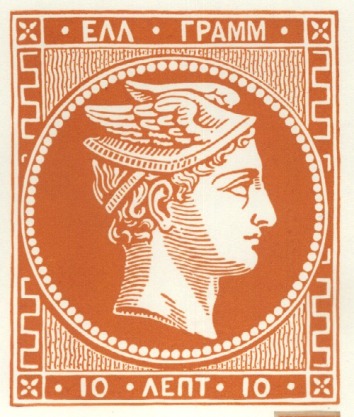Hermes
|
After nine years of cutting linoleum blocks for replicas of stamps, I was finally ready for the Holy Grail of classic stamps, the Greek Hermes of 1861. Hermes, the messenger of the Gods, is perhaps the most appropriate of all subjects for a postage stamp. These first stamps of Greece were closely modeled after the French designs of Ceres and Napoleon III, and like those earlier designs, the Hermes featured a bust in a circular medallion with a crenelated border against a background of curved lines interspersed with dots. The block was quite difficult to carve, especially the background. For each dot the block had to be rotated in a complete circle as the cutting tool delineated the margin of the dot. Every line throughout and every dot is cut so as to be wider at the base and narrow at the top printing surface, resembling a mesa in cross section. If the cut were straight down on either side, the line would fall over after only a few prints, and the block would be useless.
There are so many varieties of the Hermes that it often takes an expert to differentiate between those worth pennies and others worth hundreds, or thousands of dollars (None of those as collaged in this print are worth more than a couple of dollars). The Hermes were printed in various denominations and colors on cream, green or blue papers until 1886 when the design was modernized. |
|
Provenance:
Paper: Rives Lightweight Buff, 115 grams Paper Size: 19.5 x 13" [24.13cm x 33cm] Image Size: 4” x 5” [10.2cm x 12.7cm] Edition Size: 50 Inks Used: Van Son Rubber Based Printmaking Inks Date Cut: 15 Mar 2005 Production notes: I scanned a French postage stamp [1862 Provisional ‘49’] then printed a reversed copy onto parchment paper [Bienfang No. 100] and glued this onto the linoleum block using Photo Mount [3M No. 6092]. I cut directly through the paper using stencil cutters under a stereo dissecting microscope [Bausch & Lomb 13x’] and printed as a collage with a replica stamp glued [UHUstic Baton de colle] in the lower right corner. |
Available:
$25.00 USD $500 MXN Shipping: $15.00 with tracking to USA |

